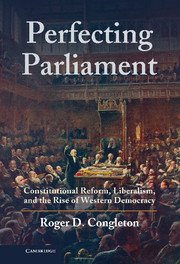Book contents
- Frontmatter
- Contents
- Preface
- 1 On the Origins of Western Democracy
- Part I Sharing Sovereignty
- Part II Historical Evidence on Western Democratic Transitions
- 9 Setting the Stage
- 10 Liberalism and Reform in the Transformative Century
- 11 Fine-Grained Constitutional Bargaining
- 12 An Overview of British Constitutional History
- 13 Constitutional Exchange in the United Kingdom
- 14 The Swedish Transition to Democracy
- 15 Constitutional Reform in the Netherlands
- 16 Germany
- 17 The Japanese Transition to Democracy and Back
- 18 The United States, an Exception or Further Illustration?
- Part III Analytical History as Social Science
- Appendix Methodological Approach, Limits, and Extensions
- References
- Index
14 - The Swedish Transition to Democracy
Published online by Cambridge University Press: 05 June 2012
- Frontmatter
- Contents
- Preface
- 1 On the Origins of Western Democracy
- Part I Sharing Sovereignty
- Part II Historical Evidence on Western Democratic Transitions
- 9 Setting the Stage
- 10 Liberalism and Reform in the Transformative Century
- 11 Fine-Grained Constitutional Bargaining
- 12 An Overview of British Constitutional History
- 13 Constitutional Exchange in the United Kingdom
- 14 The Swedish Transition to Democracy
- 15 Constitutional Reform in the Netherlands
- 16 Germany
- 17 The Japanese Transition to Democracy and Back
- 18 The United States, an Exception or Further Illustration?
- Part III Analytical History as Social Science
- Appendix Methodological Approach, Limits, and Extensions
- References
- Index
Summary
SWEDEN’S WRITTEN CONSTITUTIONAL HISTORY
Swedish constitutional history is in many ways similar to that of England, although its international entanglements and its evolutionary path differ somewhat from the English case. Sweden originated as a relatively small kingdom in the early fourteenth century at about the same time that its first constitutional documents were drafted (Helle, Kouri, and Jansson 2003, 401−2, Weibull 1993, 18−22). At its territorial peak in the seventeenth century, its domain included lands in present-day northern Germany, Poland, Russia, the Baltic states, and Finland. Norway was ruled by the Swedish king during most of the nineteenth century. Although not a small country today, Sweden is much smaller now than it was in past centuries. Its constitutional laws, perhaps surprisingly, have been more stable than the territory governed and may be argued to be among the oldest in the world.
It bears noting that usage of the term constitution in this book differs somewhat from that used by many Swedish legal scholars. “Constitution” is normally translated into Swedish as grundlag (foundational or grounding law). Under that definition, there was just one Swedish constitution during the period of greatest interest for this book. Sweden’s 1809 grounding law remained in place from 1809 until 1975. However, the Swedish constitution consists of several written laws and customary procedures with special status, rather than a single foundational document, if by constitution it is meant the core procedures through which public policies and top policy makers are chosen. Under that definition, the Swedish state may be said to have operated under at least four different constitutional systems from 1809 to 1975 because its core procedures for choosing public policies and members of parliament underwent four major reforms.
- Type
- Chapter
- Information
- Perfecting ParliamentConstitutional Reform, Liberalism, and the Rise of Western Democracy, pp. 368 - 408Publisher: Cambridge University PressPrint publication year: 2010



